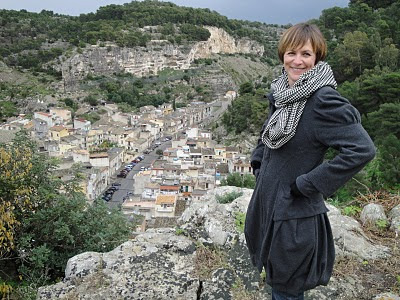
Art plays quite an important role in this very culturally-inclined city! First, the churches, with all their paintings, sculptures and statues. But also contemporary art!
Visited a few galleries. The first one exhibiting the works of several local painters who produced their own versions of ”L’Annunciazione”of Antonello da Messina (1474), preserved in Siracusa. There is also an exhibition in nearby Comiso ("Asterisco Caravaggio Contemporaneo Comiso 18 dicembre 2010 - 8 gennaio 2011") of contemporary works by local artists inspired by Carravaggio (the troublesome painter of the16th – beginning of 17th century who fled Rome, then Malta, eventually to come to Sicily…and to go back on the mainland to die!) Did not have a chance to go though.
Visited another gallery, at the suggestion of the Novecento owner, the Tecnica Mista Gallery, operated by Antonio Sarnari, the son of Franco Sarnari, the celebrated Roman painter, identified as a member of the “Gruppo di Scicli” (photo below). We get a sense of what local artists can produce at Novecento itself which has many lythographs hanging on its walls, including 6 in our room.

Then we are invited at a gathering of local painters at the gallery Correnti, next to the hotel. Quite a discussion amongst younger painters and one painter from the original Gruppo di Scicli, Franco Polizzi(?), on the meaning of a “gruppo” (which we would have totally missed, had it not been for the kind translation of Barbara Sarnari, daughter of Franco Sarnari, the painter, and sister of Antonio, who speak a very good French.) And why so much a concentration of artists around Scicli…the discussion carries on… Most of them, as we are reminded, work at other things for a living, but like to get together from time to time to exchange, and support each other I suppose. Antonio acts as a catalyst it looks like, bringing them together for instance in this place, Correnti, where some of their work is shown tonight.
We get a lithograph (aqua-tinta) of Franco Sarnari at Antonio’s gallery, entitled “Mornolo in fiore” (photo at the top)…
December 30, 2010
P.S. found an interesting website in English on arts in Scicli area (http://www.copai.it/ing/articoli/gruppo-scicli.htm)





































